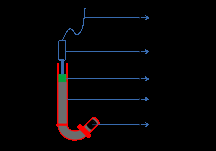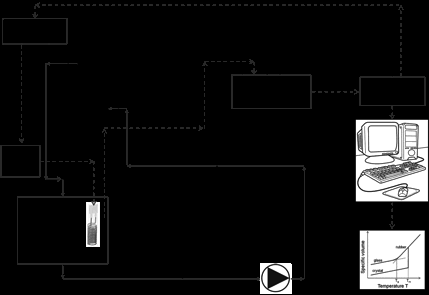Reports: ND756906-ND7: The Rigid Amorphous Fraction in Semicrystalline Polymers: Investigating Open Questions with Volume Dilatometry
Sindee L. Simon, Texas Tech University
The objective of this study is to investigate the structural relaxation process of the rigid amorphous fraction in a model semi-crystalline polymer, poly(ethylene terephthalate), using volume dilatometry. Using samples of different crystallization history and morphology, the focus is to understand the volume recovery process of the rigid amorphous fraction (RAF), to use models of structural recovery to obtain the glass transition temperature (Tg) of the RAF and its breadth, and to examine the interplay between crystallization and structural relaxation.
The dilatometer used for the investigation is based on the design of Plazek [1]. The construction of the dilatometer consists of a precision capillary tube (L: 5 cm, D: 4.68 mm) connected with a stainless steel sample holder via a KOVAR glass-to-metal seal. A Viton o-ring is used to seal the threaded joint of the sample holder. Mercury is used as the confining fluid in the dilatometer. The volume of the sample was previously obtained by measuring the height of Hg in the capillary using a linear variable differential transducer (LVDT), as shown in Fig. 1. However, that system had several disadvantages, including a limited range of the measurable height of the Hg thread and periodic drowning of the LVDT float. In order to eliminate these issues, a capacitance-based measurement technique was developed as part of the work on this grant, following Frey and Richert [2]. The capillary dilatometer is modified into a cylindrical capacitor with a silver layer (DuPont 7713) decaled on its outer surface and working as the outer electrode, whereas the mercury in the capillary serves as the inner electrode, and the glass inbetween the two works as the dielectric medium, as shown in Fig. 2. An ultra-precision capacitance (Andeen-Hagerling 2550A 1 kHz) bridge is used for precision capacitance measurements.
In order to eliminate noise in the capacitance data from magnetic interference generated by the motors of the temperature baths, we constructed a new bath for the dilatometer, as shown in Fig. 3. This custom-built bath is made out of stainless steel with fiberglass used for temperature insulation wrapping the outer surface of the bath. Two stainless steel parallel bars installed at the bottom of the bath hold the dilatometer in place with minimal vibration. Thin teflon sheets are used as electrical insulators inside the bath and around the dilatometer. An aluminum sheet is used to wrap the fiberglass and to act as the electrical conduit shield surrounding the bath and is also connected to the shield potentials of both the electrodes, i.e. the bridge itself.
The overall setup has been modified for the new bath in order to do heating/cooling runs and isothermal temperature test, as shown in Fig. 4. Two Hart Scientific precision baths (Model 6025 & Model 6330) are used as the mother baths. Rhodorsil silicone oil (47V50) is used as the heat transfer medium in the baths. Hot oil from the baths are pumped to the dilatometer bath using a magnetic-drive, close coupled centrifugal pump (Liqioflo Century Series, Model No. 620-MC) and circulated back to the baths through the return lines. Temperature control in the system is performed using the reading from the Black Stack and using NI 9265 coupled with the Fuji temperature controller (PXR4 series) equipped with auto tuning plus ramp/soak control. Data generated from the AH 2550 capacitance bridge and the Hart Scientific 1560 Black Stack are fed to the computer using a National Instrument data acquisition system. Data are filtered, binned, and then plotted with respect to time using the LabView software.
The behavior of the dilatometer filled with mercury indicates a stability in capacitance of ±1 fF (± 1 x 10-15 F), equivalent to a stability in volume of ± 2 x 10-5 cm3. The stability of the modified setup compares favorably to our previous system in which the long-term was estimated to be ± 5.0 x 10-5 cm3 for a 5 g sample. In the coming year, we plan to perform experiments for semi-crystalline polymers with varying crystallization history and morphology in order to understand volume recovery of the rigid amorphous fraction in these materials, as well as the interplay between crystallization and structural relaxation.
References
1. Craig A. Bero and Donald J. Plazek. "Volume-dependent rate processes in an epoxy resin." Journal of Polymer Science Part B: Polymer Physics 29.1 (1991): 39-47.
2. Sarah Frey and Ranko Richert. "Capacitive measurement of mercury column heights in capillaries." Review of Scientific Instruments 81.3 (2010): 034702.
Figure 1: Capillary dilatometer equipped with LVDT (Old Design)
Figure 2: Capillary dilatometer equipped acting as a cylindrical capacitor (New Design)
Figure 3: New custom-built bath for the dilatometer
Figure 4: Operational scheme of the new setup















